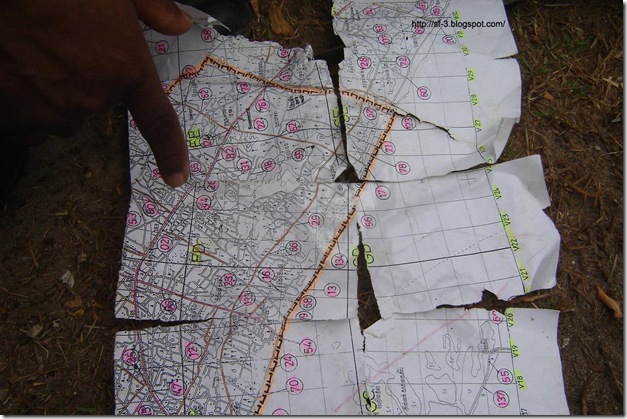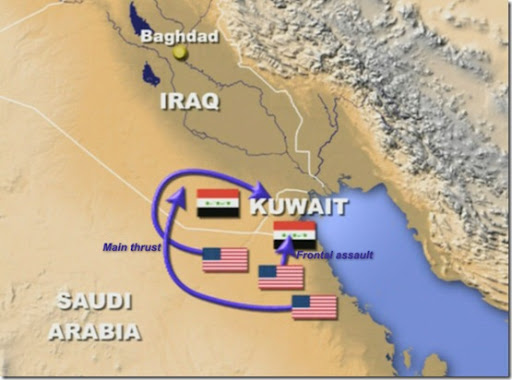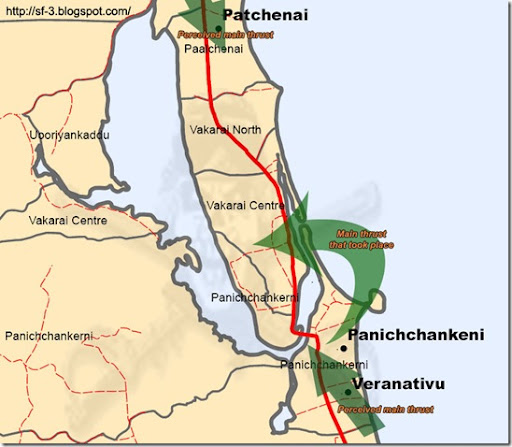EPS - Elephant pass, known for its impregnable defences comprising sophisticated chain linked and plexi glass, blended by natural defences fell to the offensive Tamil Tiger ceaseless waves III formations on the 21st of April 2000 exactly 8 years ago.
EPS till 2000 remained as a permanent impregnable cork to the Tamil Tigers allowing SLA maintain supremacy over the thin neck of land. The EPS defences extended from VETTILEIKERNY and IYAKACHCHI in the North to PARANTHAN in the South and was spread well over 70 square kilometres complete with man made satellite bases with well complimented natural obstacles of lagoon and sea fronts forming a tactically sound fortification. It was home to the 54 Division. In addition over two Divisions were deployed for its defence. How formidable and tactically sound these defences were proven by the Tamil Tigers' failed attack on that area in July-August 1991, when it was under siege for nearly two months.
The EPS defences have long been an anathema to the Tamil Tigers for it not only has denied them free access to the populous peninsula but also hindered the line of communication between the Wanni heartland and Jaffna - the focal point of the Eelam ethos.
Even though EPS fell in April 2000, the actual assault began in December 1999 on the back of the successes of Ceaseless Waves II which completely reversed the years worth of 'successful inroads' within a matter of days beginning with ODDUSUDAN. Ceaseless Waves I was the attack on the Mullaitivu defence complex which was home to the 225 brigade.
During the initial stages of the build up to the attack in an apparent prelude the Tamil Tigers commenced regular mortar barrages towards South Western part of the peninsula such as ARIYALAI and TANANKILAPPU. Barrages were also cued towards the Eastern sector of EPS. SFHQ-J COM also spoke of increased infiltration into the peninsula to conduct harassing fire towards convoys and check-posts.
On December 11, 1999 the Tamil Tigers launched Ceaseless Waves III (Oyatha Alaikal) after a brief respite during its Heroes week. With human waves attempting to break through the staunch EPS defences from the South at PARANTHAN town/junction, Sea Tigers made a landing and managed to secure a beach head by the 12th extending from VETTILEIKERNI to KADDAIKADU. Since the fall of MULATIVU, VETTILEIKERNI's radar and surveillance post was the sole point that performed maritime surveillance. In addition supplies to the entire EPS sector were unloaded here. Even though troops managed to hold on, by Friday 19th, they withdrew from the PARANTHAN town, junction and adjoining areas. This was the last Southernmost area under Government control after EPS. The fall of the satellite camps at PARANTHAN ensured that the main EPS complex would come within range of guerrilla artillery and mortars.
This brought about yet another uneasy lull to the fighting. Even though the guns were somewhat silent, the preparations for the next stage were hectic. Tamil Tigers made good use of this period to finalise their main battle plan using sand models, mock beach assaults and grid mapping (see below for example) the entire EPS area highlighting SLA strong points and breach points. Furthermore they were reinforcing the newly captured Eastern coastal belt with new trenches and bunkers supplemented with probing attacks on the Southern (just North of Paranthan Jct) and Northern (IYAKACHCHI FDL) defences.
An example of a field map of the Tamil Tigers encompassing the MUHAMALE-KILALY-NAGARKOVIL axis. This was found in a pocket of the corpse of a self styled 'Lieutenant' during the failed 2006 Jaffna offensive.
After bracing themselves for the inevitable - the final push towards EPS commenced during the early hours of 26th March 2000 when Sea Tiger units made a landing at NAGARKOVIL, thus extending the beach head from NAGARKOVIL to KADDAIKADU. Once this was secured they made a diversionary thrust using one of their companies North and North West towards KODIKAMAM and MANALKADU. While the diversion was taking place, the remaining companies breached the VATHIRAYAN box from the North and the South (cadres led by Theepan who moved North astride the coastal road passing the CHUNDIKULAM sanctuary from VETTILEIKERNI) capturing CHEMPIANPATTU, MULLIYAN, MARUTHANKERNY making troops withdraw further inland. By doing so the Tamil Tigers had created a flank East to the EPS defences.
With the coastal belt from NAGARKOVIL to KADDAIKAU fully secure, 3 more companies amounting over 1200 cadres led by Balraj moved along this coast from South and crossed the narrow lagoon just North of MARUTHANKERNY and began intercepting convoys plying along the A9 MSR. By 6th April Balraj and his men had succeeded their mission objective by capturing and holding onto a 4Km stretch of the A9 from MUHAMALE to PALLAI. They blew up a bridge at KATTIARATAN in the process.
The operations command with this development were made to re-route the MSR along the dirt tracks via KACHCHAI, ALIPALLAI towards CHAVAKACHCHERI. However, this route proved hazardous since the soft sandy earth at some points along this route did not support wheeled vehicles and made them break down on the way. In addition it came under constant mortar bombardment from the cadres stationed along the A9 and from beached units launched from the PARANTHAN coast.
Even though a counter attack by the CLI and Airmobile Brigade succeeded in re-capturing a 1Km stretch of the MSR, Tamil Tigers pressed on Northwards towards ELUTHMADUWAL, MIRUSUVIL and KODIKAMAM. This was despite Balraj's men running the risk of being boxed in at one stage. By doing so the Tamil Tigers ensured that level 1 reinforcement critically needed to reinforce EPS defences will have to deal with Balraj first before getting to EPS. Waiting in the wings, uncommitted, was Karuna and his men said to be over 1000 strong positioned South of EPS at PARANTHAN and MURASUMODDAI.
After a 2 day lull during the festive season, the Tamil Tigers made their final thrust. It originated from the Eastern flank - VATHIRAYAN. The thrust came from 3 prongs. Reinforcements were reduced only to a trickle by this stage and the fighting further North forced troops to move further inland. With the EPS defences fast dissipating Karuna made the final move by committing his reserve troops to overrun the complex. By 21st April 2000 troops were ordered to abandon the base and withdrew deploying itself in delaying positions.
Its been 8 years since this heart breaking debacle where many a dedicated officers and men laid their blood and soul in defence of this all important base. Since then with utmost dedication and patience SLA have turned the tables on the Tamil Tigers and are conducting frequent probing attacks on the very same defences that were breached. This is a portend of events yet to unfold.
Only time will tell...








